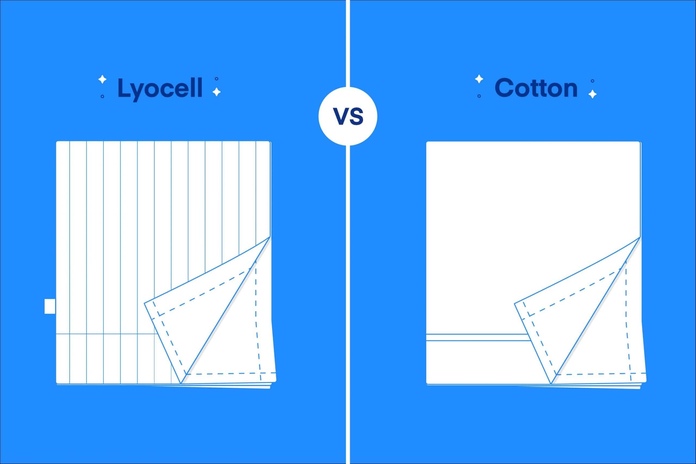When choosing bed sheets, it’s essential to take a look into how they can affect the quality of your sleep and your overall comfort. We thoroughly explore the properties of both lyocell and cotton sheets, highlighting their characteristics, benefits, and possible disadvantages to equip you with the knowledge to make a considered and informed decision.
Fabric’s Composition and Properties
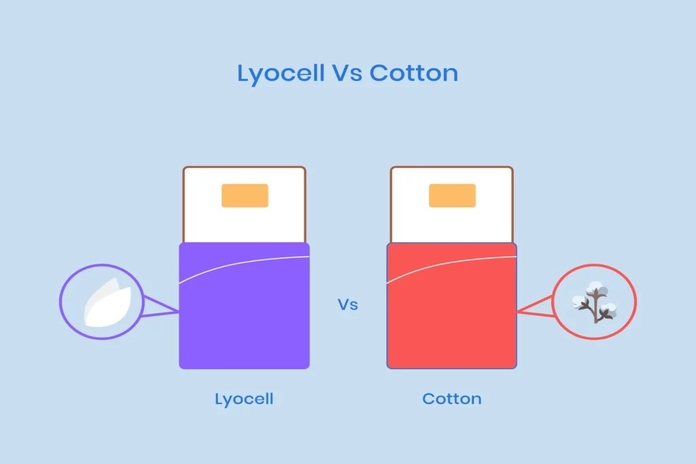
Composition
Lyocell, a semi-synthetic fiber, is derived from wood pulp, typically from eucalyptus, birch, or oak trees. The production process involves dissolving the wood pulp in a non-toxic organic compound called N-methylmorpholine N-oxide (NMMO), and then extruding the solution through small openings to create fibers. These fibers are then set in a water bath to form a material that is further processed into yarn and woven into fabric.
Cotton, on the other hand, is a natural fiber obtained from the seedpod of the cotton plant. The fibers are separated from the seeds, cleaned, spun into yarn, and eventually woven into fabric.
Properties
Lyocell
Texture: Lyocell sheets are celebrated for their incredibly soft feel, often likened to the smoothness of silk. The fibers have a naturally flat surface at the microscopic level, enhancing their luxurious sensation.
Durability: The unique manufacturing process results in strong fibers that resist pilling and maintain their strength even after numerous washes.
Moisture Management: When it comes to moisture management, Lyocell excels in absorbing moisture efficiently without feeling wet, making it especially suitable for individuals who perspire during sleep.
Thermoregulation: Lastly, the fabric’s ability to absorb and release moisture regulates body temperature, ensuring that sleepers remain cool in the summer and warm in the winter.
Cotton
Texture: Cotton sheets have a unique texture that starts crisp and only gets softer with every wash. The initial feel can vary depending on the type of weave used – percale for a crisp feel and sateen for a smoother finish.
Durability: In terms of durability, high-quality cotton sheets can last for many years if properly cared for, although they may be more prone to pilling compared to lyocell.
Breathability: When it comes to breathability, cotton is naturally breathable, allowing air to flow through and helping to regulate body temperature.
Moisture Absorption: Cotton can absorb moisture but is not as effective at wicking it away as lyocell. Heavy sweating during sleep could result in a damp sensation when using cotton sheets.
Comfort and Sleep Quality
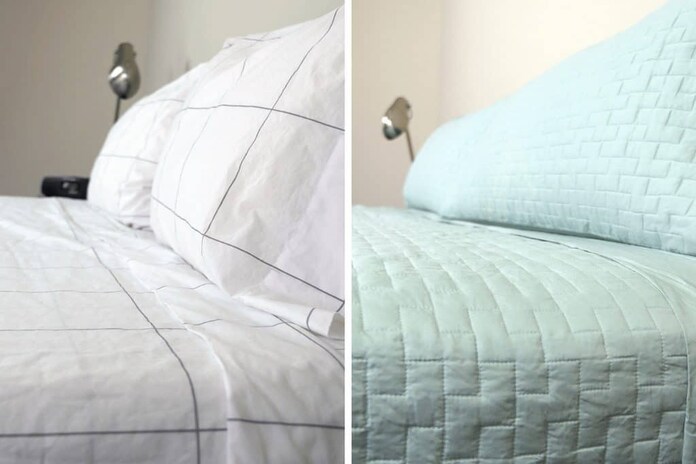
Lycell
Temperature Regulation: Lyocell sheets are known for their exceptional temperature regulation properties. The fibers contain nano-fibrils that efficiently wick moisture away from the skin and distribute it throughout the fabric, promoting rapid evaporation.
User Experience: Many people report that sleeping on Lyocell sheets provides a sensation of “barely there” comfort, like resting on a cloud. The smooth texture minimizes friction against the skin, which can be especially beneficial for those with sensitive skin or conditions like eczema.
Sleep Position Compatibility: Lyocell is suitable for all sleep positions. Side sleepers may find that the material conforms to their body contours without bunching, while back and stomach sleepers might appreciate the cool, smooth surface against larger areas of skin contact.
Cotton
Temperature Regulation: Cotton’s temperature regulation relies on its breathability rather than active moisture control. The natural fibers allow air to move through, aiding in dispersing heat and moisture, although not as effectively as lyocell.
User Experience: Cotton sheets are favored by those who appreciate a more traditional bedding feel. Many people find the incremental softening of cotton sheets satisfying, especially if they enjoy the process of breaking in their sheets over time. They often describe the sensation as “warm and comforting” or “familiar.”
Sleep Position Compatibility: Cotton’s versatility makes it suitable for various sleep positions. However, restless sleepers who frequently change positions during the night may notice their tendency to wrinkle more easily than lyocell.
Sustainability and Environmental Impact

Lyocell
Production Process: The production process of Lyocell is highly sustainable and environmentally friendly. It utilizes a closed-loop system that recycles almost all of the solvents used, leading to a significantly reduced environmental impact. This method conserves water and energy compared to traditional cotton production processes.
Raw Material Sourcing: The raw material sourcing for Lyocell is also eco-friendly, as the wood pulp used is typically sourced from sustainably managed forests. Some companies even opt for eucalyptus, a fast-growing plant that requires minimal water and pesticides.
Biodegradability: Lyocell is completely biodegradable, breaking down entirely in soil within a matter of weeks to months, without leaving behind any harmful residues.
Water Usage: In terms of water usage, the production of Lyocell requires approximately 20 times less water than cotton cultivation and processing.
Chemical Usage: Lyocell production is non-toxic and almost entirely recycled, which helps minimize chemical waste and environmental impact.
Cotton
Conventional vs. Organic: When comparing conventional and organic cotton farming, it’s obvious that conventional methods require significant resources such as water, pesticides, and fertilizers. Organic cotton is grown without synthetic pesticides or genetically modified seeds, resulting in a lower environmental impact.
Water Usage: Water plays a crucial role in cotton cultivation, with approximately 2,700 liters needed to produce enough cotton for a single t-shirt. This substantial water usage can strain local ecosystems, especially in areas with limited water resources.
Pesticide Use: Pesticide use in conventional cotton farming accounts for about 16% of global insecticide usage, despite occupying only 2.5% of agricultural land. Organic cotton production addresses this concern, but it currently represents a small fraction of global cotton production.
Biodegradability: Cotton is biodegradable. However, any chemical treatments applied during processing can influence its rate of decomposition and environmental effects.
Pricing and Value
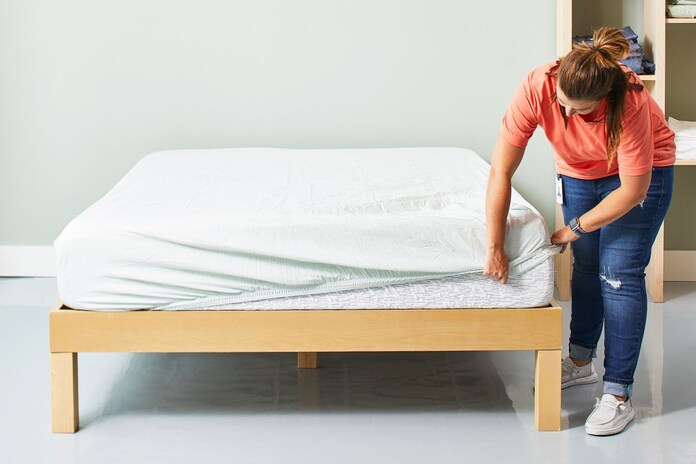
Price Range: When it comes to price, Lyocell sheets are generally considered to be on the more expensive side, with a typical range of $100 to $300 for a queen-size set. There are also luxury brands that may charge even higher prices.
Long-term Value:
Cotton
Price Range: When it comes to price, cotton sheets offer a wide range of options, with prices typically ranging from $30 to $200 for a queen-size set. Additionally, there are luxury cotton sheet options that go beyond this price range. s range.
Long-term Value: In terms of long-term value, high-quality cotton sheets can prove to be a smart investment due to their durability and the potential for increased softness as they age. It’s important to keep in mind, though, that they may need to be replaced more often than lyocell sheets.
Care and Maintenance
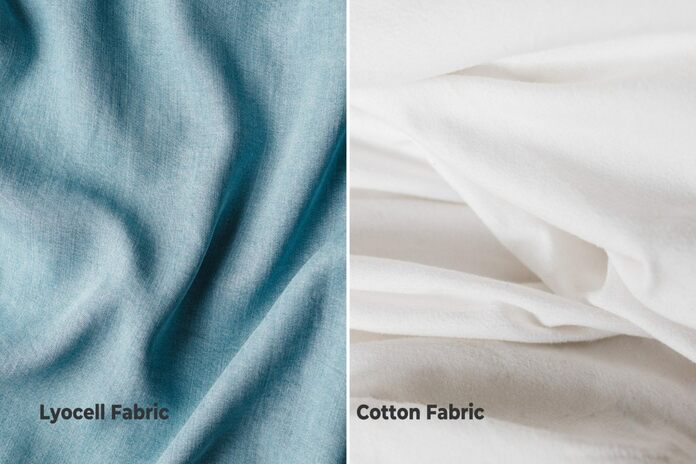
Lyocell
- Cleansing: Use a washing machine with cold or warm water on a delicate cycle.
- Drying: Employ low heat to tumble dry or air dry for optimal results.
- Pressing: If necessary, iron at a low temperature, although lyocell’s natural traits often reduce wrinkling.
- Special Considerations: Refrain from using fabric softeners, as they can cover the fibers and diminish their moisture-wicking abilities.
Cotton
Washing: When laundering your sheets, it’s recommended to wash them in the washing machine using warm water. If you have white cotton sheets, using hot water can help to maintain their brightness.
Drying: When it comes to drying, using medium heat in the tumble dryer is advisable. Be cautious not to over-dry the sheets as it can lead to excessive wrinkling.
Ironing: Ironing may be necessary for cotton sheets, especially if you prefer a crisp appearance. Cotton sheets may require more frequent ironing compared to lyocell sheets.
Special Considerations: Additionally, it’s a good idea to pre-wash new cotton sheets to eliminate any sizing agents and enhance their softness before use.
Conclusion
In conclusion, it’s important to note that lyocell and cotton each offer unique benefits tailored to different sleep preferences, budget considerations, and environmental concerns.
Lyocell stands out for its exceptional softness, efficient moisture management, and eco-friendly production processes, making it an excellent option for those who value these features and are willing to invest in top-quality bedding.
On the other hand, cotton’s well-established characteristics and widespread availability continue to make it a popular and versatile choice across various needs and budgets. Ultimately, the best choice depends on individual priorities, sleep habits, and lifestyle considerations.
FAQ
What are lyocell and cotton sheets made from?
Lyocell is derived from wood pulp, sourced from trees like eucalyptus or birch, using a sustainable, solvent-based process. In contrast, cotton is a natural fiber obtained from the seedpod of the cotton plant.
How do lyocell and cotton differ in terms of texture and feel?
Lyocell is famous for its luxuriously smooth texture, often likened to silk, while cotton has an initial crispness and tends to become softer with each wash, offering a more traditional feel.
Which material is better for moisture management and temperature regulation?
Lyocell is excellent at absorbing moisture, keeping sleepers dry and cool due to its moisture-wicking properties, whereas cotton is naturally breathable, allowing airflow to help regulate temperature.
What about durability and long-term value?
Lyocell is resistant to pilling, maintains its strength after washing, and offers long-term durability and value. Meanwhile, cotton, though durable when well cared for, may be more prone to pilling over time.
Which option is more environmentally friendly?
Lyocell is produced through a closed-loop process that minimizes environmental impact and uses sustainably sourced wood pulp. On the other hand, organic cotton reduces pesticide use and water consumption compared to conventional methods.
